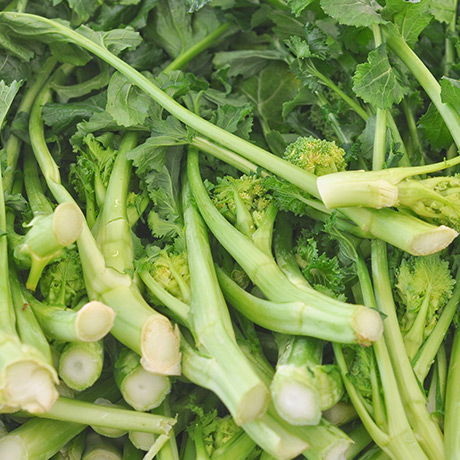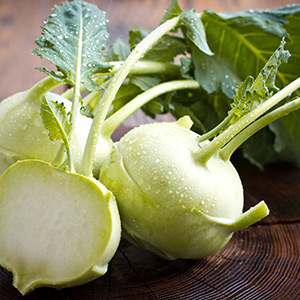- Strawberries
- Cook With Apples
- Grapes
- Grapefruit
- Lemons
- Cabbage
- Asparagus
- All About Bulb Vegetables
- All About Cruciferous Vegetables
- Squash
- All About Root Vegetables
- The Gift of Spice
- Thyme
- Basil
- Raspberries
- All About Tuber Vegetables
- Marjoram / Oregano
- Lemongrass / Citronella
- All Our Fruits, Vegetables and Fresh Herbs
- All About Exotic Fruits
- All About Legumes
- Cooking Pears: Three Inspirational Methods
All About Cruciferous Vegetables

Cruciferous vegetables are one of the most widely cultivated food, with many species from cauliflower to rapini available year-round. Cruciferous vegetables are widely known to be a good source of fibre, rich in nutrients and contain cancer-fighting properties. Here are five varieties to enjoy more of.
Artichoke
The artichoke is the bud of a vegetable belonging to the thistle family that grows in the Mediterranean region. It was much enjoyed by the Greeks and Romans, and during the Middle Ages was thought to be an aphrodisiac.
Characteristics
There are fifteen different varieties of artichoke, classified by shape and colour. They can be round or elongated and range in colour from green to violet.
The very leafy plant that produces the artichoke bud can reach 1 to 1.5 metre in height. The artichoke is picked before it flowers. The edible parts is the base, the wide end of the leaves, the heart and a few centimetres of the stem depending on its height. The hairy central core or "choke" is not edible.
Culinary tips and advice
- Choose a firm, heavy artichoke with stiff, tightly-packed green leaves. Avoid artichoke with damaged leaves or brown marks.
- Small artichokes are more tender.
- Artichoke is always cooked, but can be eaten warm or cold.
- Fresh artichokes should be trimmed and prepared just before cooking. To prevent oxidation, sprinkle with lemon juice.
- Whole artichokes can be stuffed and baked in the oven.
- Whole artichokes are often served with vinaigrette or aioli; each leaf is dipped in the condiment and the flesh on the tender end is pulled with your teeth. The rest of the leaf is discarded. Once all the leaves have been removed, dip the heart in vinaigrette and eat!
- Canned artichoke hearts are ready to eat and can be used in salads or added to various dishes.
Preparing whole artichoke
Cut off the rough end of the stalk and remove the first few leaves close to the base. Trim the thorny top part of the leaves and peel the stalk. Cook in boiling, salted water for 30-45 minutes depending on its size. When the base of the artichoke can be easily pierced with a fork, it’s ready.
Preparing artichoke hearts
To eat only the artichoke hearts, use the same preparation procedure, but tear off the stem and cut the leaves 2 or 3 centimetres above the base. Simmer artichoke hearts in water with vinegar or lemon at low heat for 15-20 minutes.
Nutritional value
The artichoke is an excellent source of potassium and magnesium. It also contains folic acid, vitamins C and B6, pantothenic acid, copper, iron, phosphorous, niacin, zinc and calcium. Eating artichoke is good for the liver because it stimulates bile secretion and acts as a diuretic.
Availability
Artichokes are available year-round in the produce section.
Storage life
The artichoke can be kept refrigerated for 4 or 5 days in a perforated plastic bag. Once cooked, it can be refrigerated for 24 hours or frozen for 6 to 8 months.

Broccoli
Broccoli was cultivated by the Romans as wild cabbage. No doubt because it looks like a small tree, the word broccoli comes from the Latin brachium which means branch.

Characteristics
Usually green, broccoli can also be purple or white. It should be picked before its small yellow flowers appear. Different varieties of broccoli have been developed, notably the broccoflower, a cross between cauliflower and broccoli.
Culinary tips and advice
- Select broccoli that is firm with good colour and tight clusters. Avoid yellowing, limp broccoli that have flowers starting to develop and wilting stalks.
- Broccoli can be eaten raw with a dip or in a salad.
- If cooked, broccoli should be al dente (tender but still crunchy) to retain its fresh taste.
- The broccoli florets cook faster than the stalk.
- Steaming is the best way to cook broccoli to retain all its nutritional elements. Place the stalks in a double boiler first and the florets a few minutes later. The stalks take about 12 minutes to cook; the florets 4 or 5.
- Cooked broccoli can be eaten warm or cold. It can be served as a vegetable accompaniment, topped with melted cheese or covered with béchamel or hollandaise sauce.
- Broccoli can be added to soups, omelettes, soufflés, stews or pasta.
Availability
Broccoli is available year-round in the produce section.
Nutritional value
Broccoli is an excellent source of potassium and Vitamin C. It also contains folic acid, Vitamin A, magnesium, pantothenic acid, iron and phosphorous. Broccoli is known to contain cancer-fighting properties.
Storage life
Broccoli can be kept from two to five days in the crisper drawer of your refrigerator. Broccoli can also be frozen, once blanched. It should be eaten within twelve months of freezing.
Cauliflower
Cauliflower is another member of the cruciferous vegetable family. It was cultivated in Egypt in 400 B.C. and became popular in Europe in the 15th Century.
Characteristics
Cauliflower has a small compact head covered with hundreds of flower clusters attached to a short stalk. To protect it from the sun, the head is surrounded with heavy green leaves that are connected to the stalk. The outer leaves are tough, while the inner leaves are tender and edible.
White cauliflower is the most commonly known but there are also purple and orange varieties. The purple cauliflower has a more delicate flavour than the white. It cooks faster, and interestingly enough, becomes green while cooking. The orange cauliflower is a hybrid with more beta carotene —25 times more than the white! — resulting in its bright colour. It has a sweet flavour and can be eaten raw or cooked.
Culinary tips and advice
- Select a small, firm, spot-free cauliflower with crisp green leaves; the freshness of the exterior provides a good indication of the freshness of the vegetable.
- Remove the outer leaves and the stem. Separate the flowers into similar-sized portions to ensure uniform cooking.
- Serve raw as an appetizer with a dip or add to soups, omelettes and quiches. It’s excellent roasted and served as a side dish. It’s also delicious topped with cheese sauce and served in pasta.
- Steaming is the best way to cook cauliflower to retain its nutrients.
Availability
Cauliflower is available year-round in the produce section.
Nutritional value
Cauliflower is an excellent source of vitamin C, folic acid and potassium, and contains vitamin B6 and niacin. It is the most easily digested of the cabbage family and is known to contain cancer-fighting properties.
Storage life
Cauliflower may be refrigerated for up to twelve days in a perforated plastic bag. It should be blanched for three minutes before freezing; keep in mind that freezing will soften the texture of cauliflower.

Rapini
The rapini or Italian broccoli originated in the Mediterranean region. It has long stems with thin leaves and small buds. All parts of the rapini are edible.

Characteristics
There are two types of rapini: the ruvo and the Italian. This member of the cruciferous family looks like broccoli and cauliflower but does not have as strong a taste or aroma.
The flavour of the stem and the florets is delicate, while the leaves taste slightly bitter.
Culinary tips and advice
- Select slender, firm rapini with bright green stems and few opened buds or flowers.
- To prepare rapini, rinse well in cold water then remove the hard parts from the base of the stem. The largest stems can be peeled if desired.
- Rapini can be steamed, boiled, sautéed or simmered at low temperature. The stalks should be cooked first because they take longer to cook than the florets.
- Rapini cooks very quickly and should be served al dente.
- It’s delicious sprinkled with vinaigrette, topped with grated cheese, or covered with béchamel sauce. It can add flavour to mashed or scalloped potatoes and great in pastas, quiches and omelettes, or simply served as a side dish.
Availability
Rapini is available year-round in the produce section.
Nutritional value
Rapini is an excellent source of Vitamin C and folic acid and contains Vitamin A, calcium, iron, magnesium, potassium, zinc and fibre. It contains cancer-fighting nutrients.
Storage life
Unwashed rapini can be kept for up to one week in the refrigerator in a perforated plastic bag. It tastes best when eaten fresh. If freezing, blanch rapidly, cool, and store in freezer bags.
Kohlrabi
Kohlrabi is the swelling of the stem of a plant originating from Northen Europe. It is thought to be a cross between wild cabbage and wild rutabaga. Though kohlrabi is quite popular in Central and Eastern Europe, it is still relatively unknown in North America.
Characteristics
About the size of an orange, kohlrabi is easily recognized by its peculiar shape: a bulbous base that grows above the ground and is covered with thin offshoots growing in all directions. Attached to this base are large leaves that are also edible.
Kohlabi can be very light green, white, or crimson. It is covered with a thin edible skin. The flesh is sweet and crunchy and tastes a little like radish. The stems taste like cabbage.
Culinary tips and advice
- Choose kohlrabi that is smooth and free of spots. Selecting one that is no bigger than 7cm in diameter ensures that it won't be stringy. Leaves (if there are any) should be firm and richly coloured.
- You can peel kohlrabi before or after cooking but the skin will be much easier to remove once cooked.
- To eat raw, first remove the stem and then peel thoroughly, removing the fibrous coating under the skin.
- Kohlrabi can also be shredded, cut in julienne strips, diced, sliced, or cut in chunks.
- Served raw, it is eaten with dip, vinaigrette or in a salad. Cooked, it can be added to soups and stews or puréed and served as a side dish.
- Kohlrabi is delicious steamed, peeled or unpeeled, drizzled with lemon juice and melted butter. It can be served with a sauce, au gratin, or prepared like celeriac. The flesh can be prepared like turnip; the leaves like spinach.
- The leaves cook in very little time and are delicious with lemon juice and butter. To steam or boil kohlrabi, you will need 20 to 30 minutes, depending on size.
Availability
Kohlrabi is available year-round in the produce section.
Nutritional value
Kohlrabi is an excellent source of vitamin C and potassium. It contains vitamin B6, folic acid, magnesium and copper. Kohlrabi leaves are rich in vitamin A.
Storage life
Kohlrabi will keep in the fridge for up to one week; store without leaves in a perforated plastic bag. Stored separately, the leaves will stay fresh for a day or two. Freezing is not recommended as it will affect the colour and consistency of the vegetable.



















